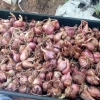Daftar referensi :
1. Anwar, Alia., M. Ashfaq, Sadaf habib, M. S. Ahmad3, H. S.-Ud-Din Mazhar3, R. M. Xing, M. A. Javed .2025. Improving the nutraceutical content of tomato (Lycopersicon esculentum) through saline and waterdeficit conditions. Advancements in Life Sciences, 12(1).
2. Chandra et al. (2024). Salicylic acid-mediated enhancement of lycopene in tomato. Journal of Applied Botany and Food Quality.
3. Choi, Y.M., et al. (2022). The roles of catechins in systemic inflammation. Food Chemistry, 373(1)
4. Dumas et al. (2023). Impact of maturity stage on lycopene concentration in tomatoes. Postharvest Biology and Technology.
5. Jomova, K., and Valko, M. 2011. Carotenoid antioxidants and their role in health and disease. Current Opinion in Clinical Nutrition & Metabolic Care, 14(6), 530--537.
6. Kamaruddin, K.S., et al. 2023. Antiinflammatory and anticancer effects of anthocyanins: A review. Antioxidants, 13(9), 1143
7. Khareta, P., M. Vashisht, M. Bhandari, S. Raj. 2021. Phytochemicals for Healthy Living: Extraction and Usage. International Journal of Technical Research & Science (Special Issue) ISSN No.:2454-2024.
8. Shi & Maguer. 2023. Thermal processing and bioavailability of lycopene in tomato products. Food Chemistry.
9. Smith, S.J. & Smith, D.M. (2024). Caffeine's role in pain management: A brief review. Journal of Pain Management, 18(5), 730.
10. Xu, J. & Liu, H. 2022. Antioxidative and hypolipidemic effects of diosgenin. Biological & Pharmaceutical Bulletin, 45(12), 3063--3070







